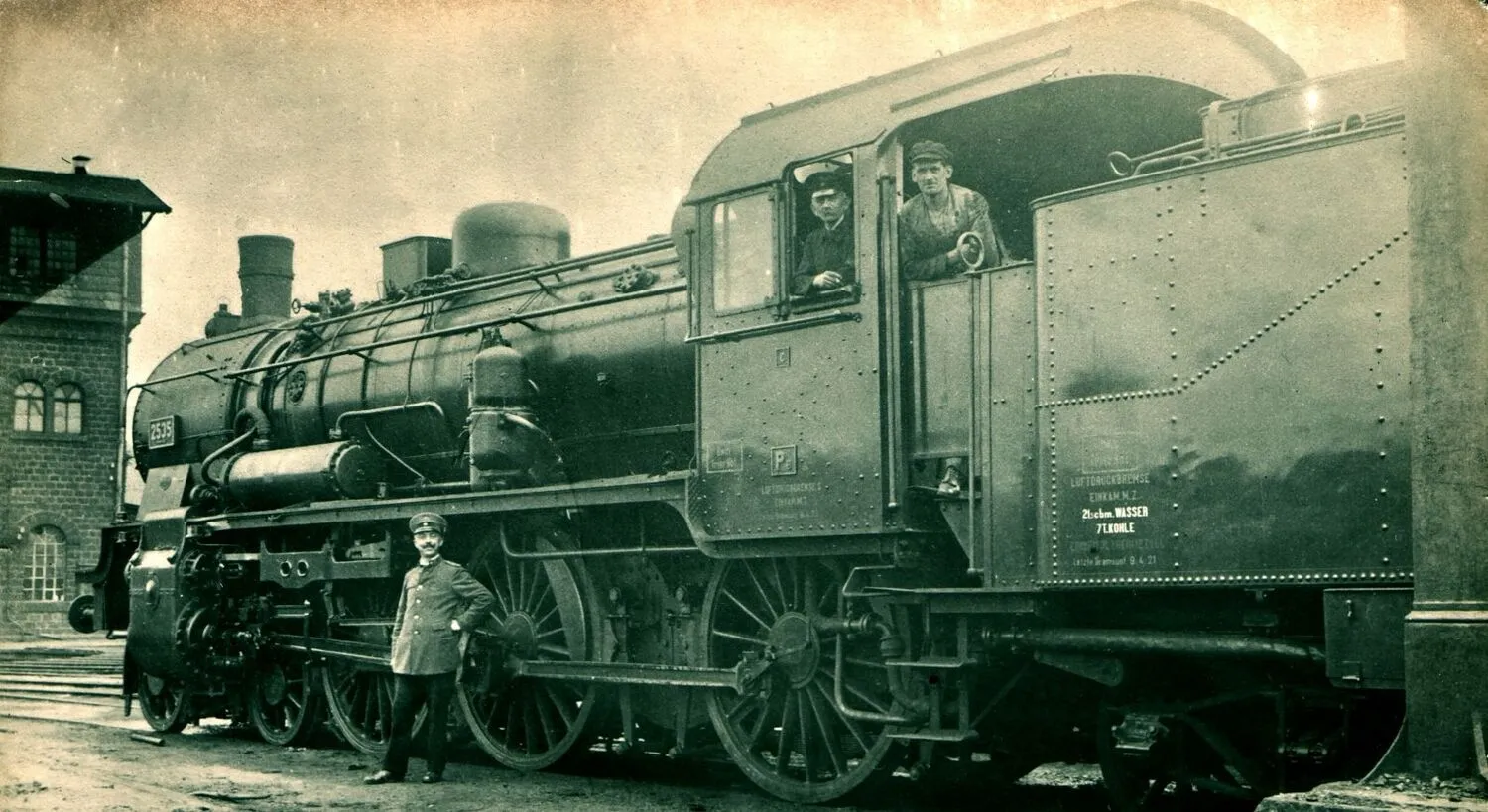P 8
Vehicle type:
Registration country:
Railway companies:
In service:
from 1906
Built by:
- Vulcan Stettin
- AEG - General Electric Company
- BMAG - Berlin Mechanical Engineering
- Borsig - Borsig Locomotive Works
- KRUPP - Friedrich Krupp
- Hanomag - Hanover Mechanical engineering
- Henschel Works
- KHD - Klöckner-Humboldt-Deutz
- Karlsruhe Engineering Works
- F. Schichau Mechanical Engineering Works
- Union Giesserei
1906
The P 8 is a passenger locomotive that is
primarily developed as a successor to the P 6 and
later serves as the basis for the development of the S
10. It is distinguished by being the most produced
passenger steam locomotive in history, with nearly 4000x units
built. The P 8 remains in service with both
railways in divided Germany until the 1970s.
Designed by Prussian construction consultant Robert Garbe, the P 8 is a relatively simple yet powerful and economical machine. After addressing some initial technical issues, the design proves to be a significant success. Garbe, a pioneer of superheated steam technology in the late 19th century, utilizes this innovation in the construction of the locomotive to achieve the required performance levels.
Initially, the new locomotive is intended for a speed rating of 110 km/h, allowing it to operate passenger express trains. However, operational testing reveals that the two-cylinder drive mechanism, along with an imperfect mass balance, is not suitable for such speeds. Consequently, the locomotive is only approved for a maximum speed of 100 km/h. The stability of the P 8 remains one of its most significant drawbacks, particularly the slightly loose coupling to the tender that results in poor handling during reverse travel, limiting this speed to 50 km/h. Improvements occur in later years when the bathtub tenders from wartime locomotives are utilized with the P 8, allowing for reverse speeds of up to 85 km/h.
Overall, the P 8 is a successful design, particularly praised for the performance of its boiler. The firebox extends slightly into the long boiler, functioning somewhat like a combustion chamber, which contributes to its excellent evaporation performance.
Between 1906 and the end of World War I, 2350x units are constructed, with some locomotives produced for the railways of Oldenburg, Baden, and Mecklenburg. As the locomotive’s positive attributes become known among the victorious powers, 627 units are handed over as reparations. To replenish stock, production continues until 1923, involving all German locomotive manufacturers except for the Saxon machine factory Hartmann and the Esslingen machine factory. Ultimately, the total number of built P 8 locomotives reaches 3948x.
During the interwar period, the Reichsbahn employs the P 8 across nearly all train categories, reserving only heavy express and freight trains for better-suited machines. Passenger steam locomotives with a wheel arrangement of 2'C are classified under the series 38, with the P 8 constituting the majority of this classification, specifically the numbering range of 3810-40. Even after World War II, both German railways continue to rely on the locomotives, leading to their retirement from service in the Reichsbahn in 1972 and the Bundesbahn in 1974.
Designed by Prussian construction consultant Robert Garbe, the P 8 is a relatively simple yet powerful and economical machine. After addressing some initial technical issues, the design proves to be a significant success. Garbe, a pioneer of superheated steam technology in the late 19th century, utilizes this innovation in the construction of the locomotive to achieve the required performance levels.
Initially, the new locomotive is intended for a speed rating of 110 km/h, allowing it to operate passenger express trains. However, operational testing reveals that the two-cylinder drive mechanism, along with an imperfect mass balance, is not suitable for such speeds. Consequently, the locomotive is only approved for a maximum speed of 100 km/h. The stability of the P 8 remains one of its most significant drawbacks, particularly the slightly loose coupling to the tender that results in poor handling during reverse travel, limiting this speed to 50 km/h. Improvements occur in later years when the bathtub tenders from wartime locomotives are utilized with the P 8, allowing for reverse speeds of up to 85 km/h.
Overall, the P 8 is a successful design, particularly praised for the performance of its boiler. The firebox extends slightly into the long boiler, functioning somewhat like a combustion chamber, which contributes to its excellent evaporation performance.
Between 1906 and the end of World War I, 2350x units are constructed, with some locomotives produced for the railways of Oldenburg, Baden, and Mecklenburg. As the locomotive’s positive attributes become known among the victorious powers, 627 units are handed over as reparations. To replenish stock, production continues until 1923, involving all German locomotive manufacturers except for the Saxon machine factory Hartmann and the Esslingen machine factory. Ultimately, the total number of built P 8 locomotives reaches 3948x.
During the interwar period, the Reichsbahn employs the P 8 across nearly all train categories, reserving only heavy express and freight trains for better-suited machines. Passenger steam locomotives with a wheel arrangement of 2'C are classified under the series 38, with the P 8 constituting the majority of this classification, specifically the numbering range of 3810-40. Even after World War II, both German railways continue to rely on the locomotives, leading to their retirement from service in the Reichsbahn in 1972 and the Bundesbahn in 1974.
Sources: https://www.loco-info.com/view.aspx?id=10805&t=Type&cookies=decline
1921
After the German Imperial Railways company (DRG) is founded in
1921, the remaining units from this series will be registered as
Class
38.10 with the new company.
Do you have additional informations regarding this vehicle?
Help us writing the history of P 8! Your knowledge is precious for us and the entire community, do not hesitate to share your facts, photos or videos:
Latest update on the 21st of December 2024 at 22:51
Contributor(s): Tudor C.
Discussion forum




